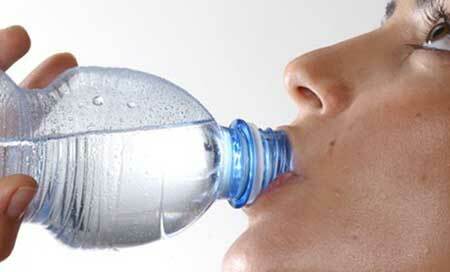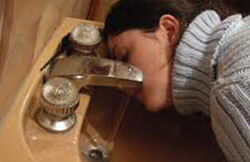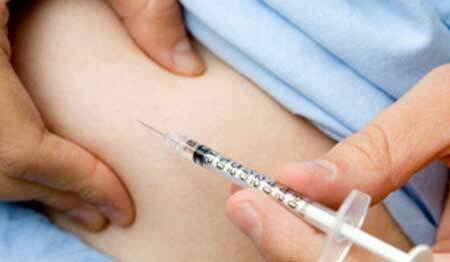Non-diabetes is also called diabetes insipidus - this pathology is very rare in people, in about 2 cases, 60,000 people.
Contents of
- 1 What is diabetes insipidus?
- 2 Causes of diabetes insipidus
- 3 Signs and symptoms of diabetes insipidus
- 3.1 Symptoms of diabetes insipidus in women
- 4 Diagnosis of diabetes insipidus
- 5 Treatment of diabetes insipidus
- 6 Complications of diabetes insipidus
- 7 Diabetes in diabetes insipidus
What is diabetes insipidus?

Thirst is caused by constant urge to urinate
Diabetes is an endocrine disease caused by an inadequate production of an antidiuretic hormone by the hypothalamus, resulting in a decrease in the density of excreted urine and its excessive secretion( up to 12 liters per day).
The disease is most common in women older than 40 years.
Classification of
First of all, one should know that diabetes of a non-sugar type can be of two forms:
- Central form.
- Renal form.
Most often there is a central form of the disease, which is divided into idiopathic( arising without cause) diabetes and symptomatic( develops under the influence of certain environmental and internal environment factors).
There is also congenital diabetes insipidus, which develops as a result of chromosomal abnormalities.
Causes of diabetes insipidus
 The following predisposing factors may cause the development of a diabetes insipidus symptomatic diabetes:
The following predisposing factors may cause the development of a diabetes insipidus symptomatic diabetes:
- Dysfunction of the hypothalamus or pituitary gland, as a result of which the production of antidiuretic hormone is disrupted;
- Tumors in the brain of a benign or malignant character;
- Spreading of metastases to the brain;
- Postponed surgical intervention, trepanation of the skull;
- Received craniocereberal trauma;
- Vascular insufficiency;
- Tuberculosis, malaria, syphilis and other infectious diseases.
In the idiopathic form of diabetes insipidus in the patient's body, antibodies, which destroy the cells producing antidiuretic hormone, begin to be produced for no apparent reason.
Renal diabetes insipidus( renal form) occurs as a result of intoxication of the body with chemicals, disorders or transferred kidney and urinary system diseases( renal failure, hypercalcinosis, amyloidosis, glomerulonephritis).
Signs and symptoms of diabetes insipidus
Highlights the symptoms that are most characteristic for diabetes insipidus:
- PPP - polyuria, polyphagia, polydipsia( increased urination, hunger, thirst).The volume of urine in diabetes insipidus can reach about 12-18 liters per day. Due to the large amount of urine released, its density and specific gravity decrease, as a result of which it acquires transparency and colorlessness, has no odor, salts, and uniform elements;
- Neurosis - develops in patients as a concomitant symptom, as the constant urge to urinate disrupts the habitual rhythm of life and badly bothers the patient;
- Insomnia;
- Increased secretion of sweat and salivary glands, resulting in the skin and mucous membranes of the patient become dry;
- The appearance of microscopic cracks in the skin and mucous membranes as a result of their excessive dryness, it is possible to attach a secondary bacterial infection when pathogenic microorganisms penetrate into the wound;
- Dehydration of the body;
- Rapid weight loss;
- Omission of internal organs, as a result of which their work and functions are disrupted.
Even if the patient limits the use of liquid urine will still be released in large quantities, which will lead to a general dehydration of the body.
Symptoms of diabetes insipidus in women

Non-diabetes mellitus in women with pregnancy
Symptoms of diabetes insipidus in women add to menstrual irregularities, omission of the uterus, the inability to conceive and endure a child.
In some women, diabetes insipidus develops on late pregnancy and is caused by the destruction of the placenta by the enzymes of the hormone vasopressin( antidiuretic hormone).
In a similar situation, the disease requires control and supervision and passes on its own soon after the birth of the child.
Diagnosis of diabetes insipidus
If there is increased thirst and increased urination, the patient should consult an endocrinologist.
A specialist will collect an anamnesis and appoint a patient to submit a urine test for Zimnitskiy - they give out jars in the amount of 9 pieces( 8 and 1 spare), in which the patient must urinate every 3 hours. This study allows you to estimate the daily amount of urine and the work of the kidneys.
The urine collected for the day is studied in detail, evaluate it:
- Quantity;
- Specific gravity and density;
- The content of salts and minerals;
- Number of shaped cell elements.
In order to rule out diabetes, a fasting blood test is recommended.
To determine the cause of diabetes insipidus, the patient undergoes CT or MRI - these studies can accurately detect the presence of lesions, tumors or metastases in the brain.
In addition, the patient is shown a consultation with a urologist or nephrologist.
Treatment of diabetes insipidus

A successful outcome of therapy for this pathology is to accurately identify and eliminate the main cause of failure of vasopressin production, for example, a tumor or metastases in the brain in the central form of diabetes insipidus.
Preparations for diabetes insipidus are chosen by the attending physician, they are all synthetic analogues of antidiuretic hormone. Depending on the duration of the drug, the drug should be taken several times a day or 1 time in several days( preparations of prolonged action).
Diabetes of the non-sugar type of the central form is most often used with preparations of Carbamazepine or Chlorpropamide - these drugs stimulate the production and isolation of vasopressin.
In order to prevent dehydration of the body against a background of profuse and frequent urination, intravenously drip the patient with saline solutions.
Treatment of diabetes insipidus in women is an additional consultation of a gynecologist and correction of the menstrual cycle.
Complications of diabetes insipidus
A dangerous complication of the disease is the loss of fluid by the body, since, despite the increased thirst, water supplies are not replenished fully.
The signs of dehydration can be recognized by the presence of the following symptoms:
- Increase in general weakness;
- Rapid heart rate;
- Swelling of lower extremities;
- Vomiting, nausea;
- The pronounced odor of acetone from the mouth, which is caused by the thickening of blood and the accumulation of ketone bodies;
- Decrease in blood pressure;
- Neurological disorders;
- Loss of consciousness;
- Acute vascular insufficiency.
- In severe cases, the coma and lethal outcome of develop.
Diet for diabetes insipidus
Diabetes in diabetes insipidus is an important part of effective therapy. In order to reduce the burden on the kidneys, the intake of animal protein should be sharply limited.
Diet consists of plant products, cereals, fruits. Meals should be broken 7-8 times in small portions.
To quench your thirst, juices, smoothies, compotes, pure non-carbonated mineral water are excellent.



